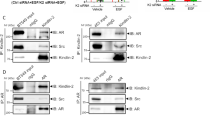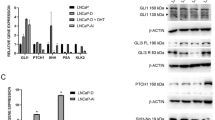Abstract
In human mammary and prostate cancer cells, steroid hormones or epidermal growth factor (EGF) trigger association of the androgen receptor (AR)-estradiol receptor (ER) (α or β) complex with Src. This interaction activates Src and affects the G1 to S cell cycle progression. In this report, we identify the sequence responsible for the AR/Src interaction and describe a 10 amino-acid peptide that inhibits this interaction. Treatment of the human prostate or mammary cancer cells (LNCaP or MCF-7, respectively) with nanomolar concentrations of this peptide inhibits the androgen- or estradiol-induced association between the AR or the ER and Src the Src/Erk pathway activation, cyclin D1 expression and DNA synthesis, without interfering in the receptor-dependent transcriptional activity. Similarly, the peptide prevents the S phase entry of LNCaP and MCF-7 cells treated with EGF as well as mouse embryo fibroblasts stimulated with androgen or EGF. Interestingly, the peptide does not inhibit the S phase entry and cytoskeletal changes induced by EGF or serum treatment of AR-negative prostate cancer cell lines. The peptide is the first example of a specific inhibitor of steroid receptor-dependent signal transducing activity. The importance of these results is highlighted by the finding that the peptide strongly inhibits the growth of LNCaP xenografts established in nude mice.
This is a preview of subscription content, access via your institution
Access options
Subscribe to this journal
Receive 50 print issues and online access
$259.00 per year
only $5.18 per issue
Buy this article
- Purchase on Springer Link
- Instant access to full article PDF
Prices may be subject to local taxes which are calculated during checkout








Similar content being viewed by others
Abbreviations
- BrdU:
-
bromodeoxyuridine
- EGF:
-
epidermal growth factor
- EGFR:
-
epidermal growth factor receptor
- ER:
-
estradiol receptor
- hAR:
-
human androgen receptor
References
Bonaccorsi L, Carloni V, Muratori M, Salvatori A, Giannini A, Carini M et al. (2006). Androgen receptor expression in prostate carcinoma cells suppresses α6β4 integrin-mediated invasive phenotype. Endocrinology 141: 3172–3182.
Castoria G, Barone MV, Di Domenico M, Bilancio A, Ametrano D, Migliaccio A et al. (1999). Non-transcriptional action of oestradiol and progestin triggers DNA synthesis. EMBO J 18: 2500–2510.
Castoria G, Lombardi M, Barone MV, Bilancio A, Di Domenico M, Bottero D et al. (2003). Androgen-stimulated DNA synthesis and cytoskeletal changes in fibroblasts by a nontranscriptional receptor action. J Cell Biol 161: 547–556.
Castoria G, Migliaccio A, Bilancio A, Di Domenico M, de Falco A, Lombardi M et al. (2001). PI3-kinase in concert with Src promotes the S-phase entry of oestradiol-stimulated MCF-7 cells. EMBO J 20: 6050–6059.
Castoria G, Migliaccio A, Di Domenico M, Lombardi M, de Falco A, Varricchio L et al. (2004). Role of atypical protein kinase C in estradiol-triggered G1/S progression of MCF-7 cells. Mol Cell Biol 24: 7643–7653.
Castoria G, Migliaccio A, Nola E, Auricchio F . (1988). In vitro interaction of estradiol receptor with Ca2+-calmodulin. Mol Endocrinol 2: 167–174.
Cato AC, Nestl A, Mink S . (2002). Rapid actions of steroid receptors in cellular signaling pathways. Sci STKE 138: RE9.
Chang CS, Kokontis J, Liao ST . (1988). Molecular cloning of human and rat complementary DNA encoding androgen receptors. Science 240: 324–326.
Chen CD, Welsbie DS, Tran C, Baek SH, Chen R, Vessella R et al. (2004). Molecular determinants of resistance to antiandrogen therapy. Nat Med 10: 33–39.
Coussens LM, Werb Z . (2002). Inflammation and cancer. Nature 420: 860–867.
Culig Z, Hobisch A, Cronauer MV, Radmayr C, Trapman J, Hittmair A et al. (1994). Androgen receptor activation in prostatic tumor cell lines by insulin-like growth factor-I, keratinocyte growth factor, and epidermal growth factor. Cancer Res 54: 5474–5478.
Cunha GR, Hayward SW, Wang YZ . (2002). Role of stroma in carcinogenesis of the prostate. Differentiation 70: 473–485.
Gururaj AE, Rayala SK, Vadlamudi RK, Kumar R . (2006). Novel mechanisms of resistance to endocrine therapy: genomic and nongenomic considerations. Clin Cancer Res 12: 1001s–1007s.
Kay BK, Williamson MP, Sudol M . (2000). The importance of being proline: the interaction of proline-rich motifs in signaling proteins with their cognate domains. FASEB J 14: 231–241.
Kousteni S, Bellido T, Plotkin LI, O'Brien CA, Bodenner DL, Han L et al. (2001). Nongenotropic, sex-nonspecific signaling through the estrogen or androgen receptors: dissociation from transcriptional activity. Cell 104: 719–730.
Levin ER . (2003). Bidirectional signaling between the estrogen receptor and the epidermal growth factor receptor. Mol Endocrinol 17: 309–317.
Lopez-Otin C, Diamandis EP . (1998). Breast and prostate cancer: an analysis of common epidemiological, genetic, and biochemical features. Endocrinol Rev 19: 365–369.
Marquez DC, Lee J, Lin T, Pietras RJ . (2001). Epidermal growth factor receptor and tyrosine phosphorylation of estrogen receptor. Endocrine 16: 73–81.
Migliaccio A, Castoria G, Di Domenico M, de Falco A, Bilancio A, Lombardi M et al. (2000). Steroid-induced androgen receptor-oestradiol receptor beta-Src complex triggers prostate cancer cell proliferation. EMBO J 19: 5406–5417.
Migliaccio A, Di Domenico M, Castoria G, de Falco A, Bontempo P, Nola E et al. (1996). Tyrosine kinase/p21ras/MAP-kinase pathway activation by estradiol-receptor complex in MCF-7 cells. EMBO J 15: 1292–1300.
Migliaccio A, Di Domenico M, Castoria G, Nanayakkara M, Lombardi M, de Falco A et al. (2005). Steroid receptor regulation of epidermal growth factor signaling through Src in breast and prostate cancer cells: steroid antagonist action. Cancer Res 65: 10585–10593.
Migliaccio A, Piccolo D, Castoria G, Di Domenico M, Bilancio A, Lombardi M et al. (1998). Activation of the Src/p21ras/Erk pathway by progesterone receptor via cross-talk with estrogen receptor. EMBO J 17: 2008–2018.
Pandini G, Mineo R, Frasca F, Roberts Jr CT, Marcelli M, Vigneri R et al. (2005). Androgens up-regulate the insulin-like growth factor I receptor in prostate cancer cells. Cancer Res 65: 1849–1857.
Simoncini T, Hafezi-Moghadam A, Brazil DP, Ley K, Chin WW, Liao JK . (2000). Interaction of oestrogen receptor with the regulatory subunit of phosphatidylinositol-3-OH kinase. Nature 407: 538–541.
Singer CA, Figueroa-Masot XA, Batchelor RH, Dorsa DM . (1999). The mitogen-activated protein kinase pathway mediates estrogen neuroprotection after glutamate toxicity in primary cortical neurons. J Neurosci 19: 2455–2463.
Song RX, McPherson RA, Adam L, Bao Y, Shupnik M, Kumar R et al. (2002). Linkage of rapid estrogen action to MAPK activation by ERalpha-Shc association and Shc pathway activation. Mol Endocrinol 16: 116–127.
Vadlamudi RK, Manavathi B, Balasenthil S, Nair SS, Yang Z, Sahin AA et al. (2005). Functional implications of altered subcellular localization of PELP1 in breast cancer cells. Cancer Res 65: 7724–7732.
Verrijdt G, Schoenmakers E, Haelens A, Peeters B, Verhoeven G, Rombauts W et al. (2000). Change of specificity mutations in androgen-selective enhancers. Evidence for a role of differential DNA binding by the androgen receptor. J Biol Chem 275: 12298–12305.
Wong CW, McNally C, Nickbarg E, Komm BS, Cheskis BJ . (2002). Estrogen receptor-interacting protein that modulates its nongenomic activity-crosstalk with Src/Erk phosphorylation cascade. Proc Natl Acad Sci USA 99: 14783–14788.
Zhao XY, Malloy PJ, Krishnan AV, Swami S, Navone NM, Peehl DM et al. (2000). Glucocorticoids can promote androgen-independent growth of prostate cancer cells through a mutated androgen receptor. Nat Med 6: 703–706.
Acknowledgements
We thank F Claessens for 3416 ARE-Luc construct, A Belfiore for AR-negative PC3 and DU145 cells and L Altucci for ERE-luc construct. Zeneca (Italy) provided the antiestrogen ICI 182,780 and Casodex. The technical assistance of Flavia Vitale is also acknowledged. This research was supported by grants from the Associazione Italiana per la Ricerca sul Cancro (AIRC), the Ministero dell'Università e della Ricerca Scientifica (Cofin 2006), and the Intramural Research Program of the National Institutes of Health, National Cancer Institute, Center for Cancer Research.
Author information
Authors and Affiliations
Corresponding author
Rights and permissions
About this article
Cite this article
Migliaccio, A., Varricchio, L., De Falco, A. et al. Inhibition of the SH3 domain-mediated binding of Src to the androgen receptor and its effect on tumor growth. Oncogene 26, 6619–6629 (2007). https://doi.org/10.1038/sj.onc.1210487
Received:
Revised:
Accepted:
Published:
Issue Date:
DOI: https://doi.org/10.1038/sj.onc.1210487
Keywords
This article is cited by
-
The nerve growth factor-delivered signals in prostate cancer and its associated microenvironment: when the dialogue replaces the monologue
Cell & Bioscience (2023)
-
Estrogens drive the endoplasmic reticulum-associated degradation and promote proto-oncogene c-Myc expression in prostate cancer cells by androgen receptor/estrogen receptor signaling
Journal of Cell Communication and Signaling (2023)
-
Androgen receptor function and targeted therapeutics across breast cancer subtypes
Breast Cancer Research (2022)
-
Identification of evodiamine as a suppressor of prostate cancer progression by reducing AR transcriptional activity via targeting Src
Endocrine (2022)
-
Communication between cells: exosomes as a delivery system in prostate cancer
Cell Communication and Signaling (2021)



